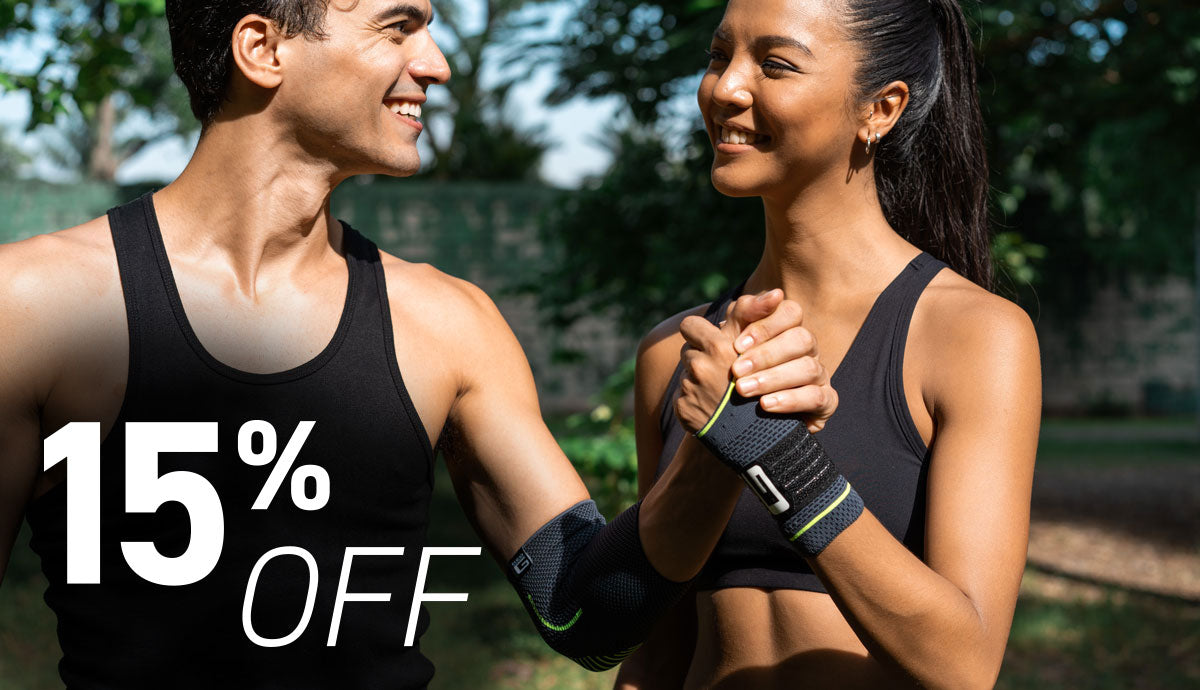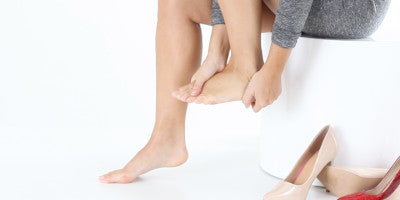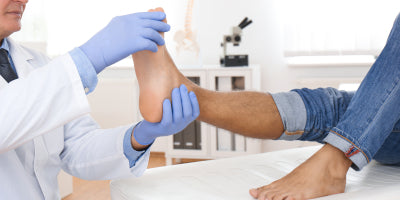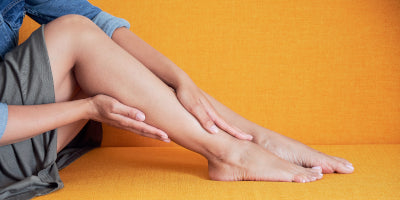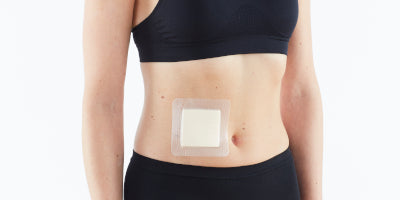Compression Hosiery Buying Guide
Compression hosiery comes in various styles, lengths and compression levels but ultimately they all work in the same way. By providing a firm, continuous pressure to the muscles and veins in the leg with more pressure being exerted at the ankle, blood is encouraged to flow up the leg. By helping blood flow back towards the heart, the compression socks support the natural function of the valves in the veins and therefore reduce the occurrence of blood pooling in the lower extremities.
What Compression Level Do I Need?
The most important factor in purchasing compression hosiery is ensuring you are wearing the correct compression level for your needs. Always look at the mmHg level indicated on the stockings if comparing brands, as different brands can indicate mild, moderate and firm compression throughout their range of products, but the mmHg levels may be different. The compression level can either be indicated as a range or as a single number and this relates to the pressure that is exerted at the ankle. Basically, the greater the compression level, or compression strength, the tighter the compression hosiery. These levels are measured in millimetres of mercury (mmHg). It's the same scale used to measure your blood pressure.
Specific Conditions where you may be prescribed compression socks are:
Varicose veins (swollen blood vessels)
Lymphoedema (swollen body tissues)
Aside from that, they would be used for improving circulation, reducing swelling and, depending on the type, reducing the risk of blood clots.
The below is a general guide. The severity of a certain issue will help determine the level needed.
15-20mmHg:
-
Everyday relief of tired, aching legs
-
Prevention and relief of minor to moderate varicose veins, such as during pregnancy
-
Relief of minor swelling of feet and legs
-
An aid for enhanced circulation, especially in the legs
-
Extra support on busy, active days or when travelling
20-30mmHg:
-
The most commonly prescribed compression level by doctors
-
Prevention and relief of moderate to severe varicose veins
-
Treatment of moderate to severe lymphatic oedema
-
Management of active ulcers or post thrombotic syndrome
-
Relief for chronically painful, heavily fatigued legs
18mmHg Anti-Embolism:
-
Used to help reduce the risk of DVT (Deep Vein Thrombosis) in surgical and/or bedridden patients
-
A pre- and post-operative aid to help reduce the symptoms of tired, aching legs
Which Style Should I Choose?
Compression socks come in various lengths, styles and colours. The actual style you choose is generally personal preference.
Any issues above the knee will require a thigh high stocking as a minimum length.
Open toes are useful if you have large feet in comparison to your ankle, as the size of the compression hosiery is determined by your ankle measurement, not your shoe size. The open toe will help you put on your compression socks more easily and ensure they are comfortable.
You may want to consider different compression socks for different occasions or uses. Here are some of our favourites:
15-20mmHg:
Energizing Trouser Knee Highs – featuring a soft, sheer material, giving the impression of standard stockings
Energizing Active Socks – perfect for active lifestyles and sporting activities
20-30mmHg:
Knee High Compression Hosiery – choose beige to be discreet under your outfit
Therapeutic Men’s Compression Socks – designed specifically for men
What is the correct compression sock size for me?
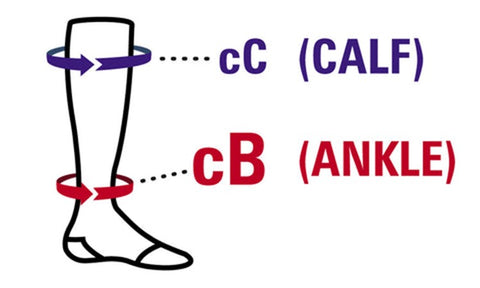
- The narrowest part of your ankle
- The widest part of your calf
For stockings above the knee you should also take a measurement in the thigh area at the point where the socks would ideally be reaching. Some manufacturers will also offer different lengths of sock so they may advise measuring from the heel to a certain point on the leg. If a manufacturer suggests measuring this length it is advisable to do so, as it is more likely the compression will be applied correctly to the key areas e.g. highest compression at the ankle.
As our bodies come in different shapes and sizes, you may find that one measurement falls into one particular size and the other falls into a size up or down. If you are fitting for yourself, we would suggest trying the larger size first, as you are less likely to cause any restriction. However, if you are being fitted by a medical professional they will use their clinical judgement for your individual needs.
One tip would be not to look at quick guides based on shoe sizes, as this can easily give inaccurate sizing for individuals, especially if you have large feet but a small ankle. Particular attention should be made to the ankle measurement, as this area will be the tightest part of the compression sock. Therefore, if you have wide feet, it is important that the sock has enough stretch to allow your foot to pass through while still providing adequate compression and not being overly tight.
How to put on compression socks
It is really important your compression socks are fitted correctly so that they are giving you the support you need and if worn properly they should be comfortable.
Compression socks can be a little difficult to get on, so below are some tips on ways to make it easier, but as always, read the manufacturer's guide on how to apply, as these could differ between brands.
- It is generally advised to only wear stockings during the day, so applying your stockings first thing will help, as you have likely had your feet either raised of level during the night, which will help reduce swelling in the feet.
- Turn the sock inside out leaving just the toe and heel area in a small pocket. This should ensure that the toe and heel can be placed in the correct position. If using open toe socks then you will only need to ensure the heel area is in the correct position. The Neo G travel & flight compression socks have a specific heel cup to help with accurate positioning. Ensure the heel is fully in this area.
- Once the toe and heel are positioned correctly, start by rolling the sock up your leg, ensuring that the sock is smooth all the way up the leg; any ridges can cause extra pressure to that point.
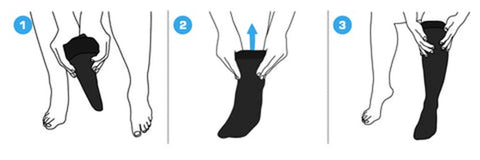
In addition to these tips, you may find that some manufacturers of open toe socks or stockings include an application sock, which can go over the foot while you are applying the sock. This reduces friction, making it easier to apply the sock over the foot and ankle area, which is usually the most difficult.
Caring for your compression socks
Caring for your compression socks properly will increase their lifespan.
As with all hosiery, compression socks should be washed regularly to prevent bacteria build up. Daily washing is preferred, but wash at least every two days. Therefore it is advisable to buy a few pairs to give you more time and flexibility. When not in use, store your socks in a cool, dry place away from direct heat and sunlight.
Compression Hosiery is delicate and needs to be washed with care so as not to damage the beneficial properties of the fabric. Turn your socks inside out and hand wash in cool water with a mild detergent. Never use fabric softener or bleach. After washing, roll your stockings in a towel to gently squeeze out the excess water, but do not wring and dry your socks flat or air dry away from direct heat. Do not tumble dry or iron.
